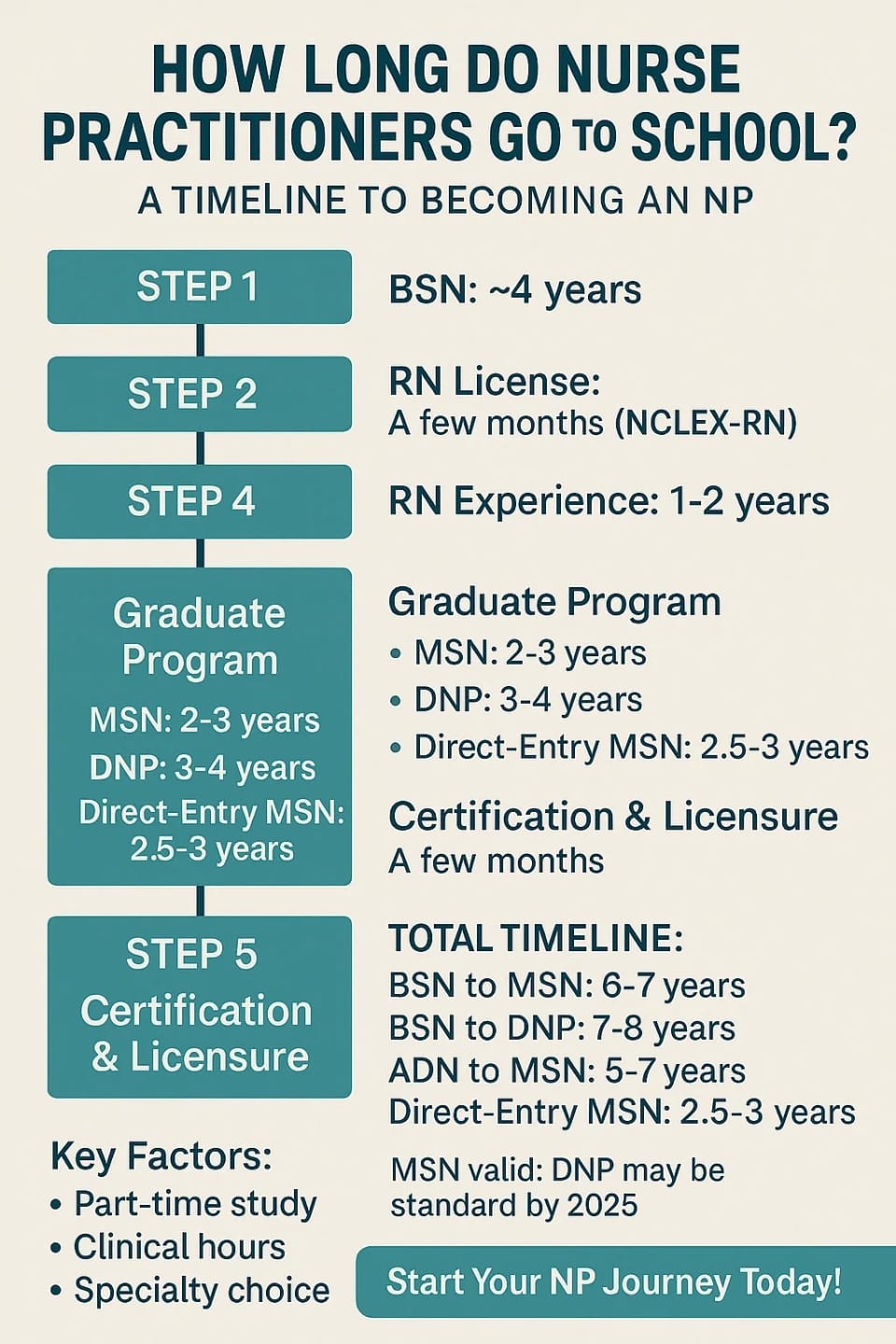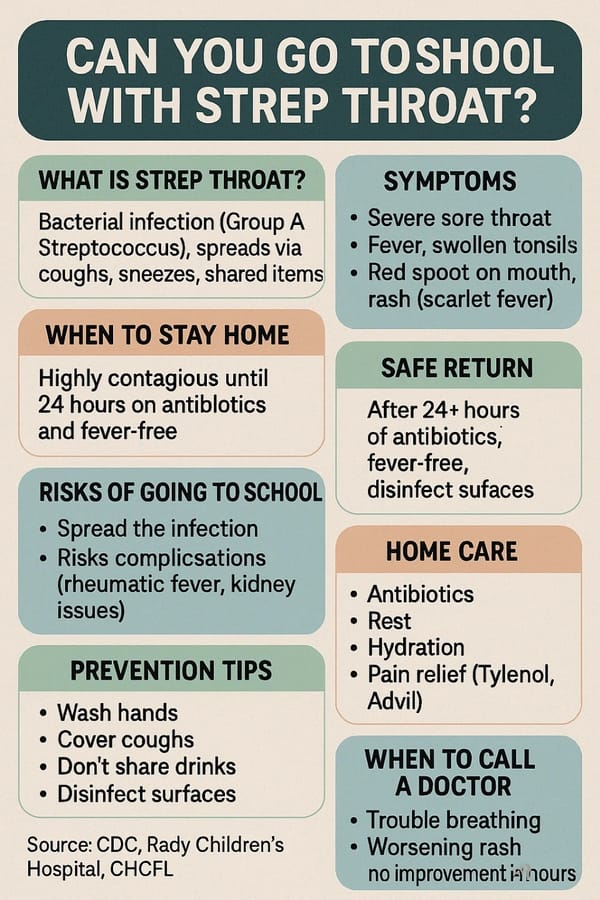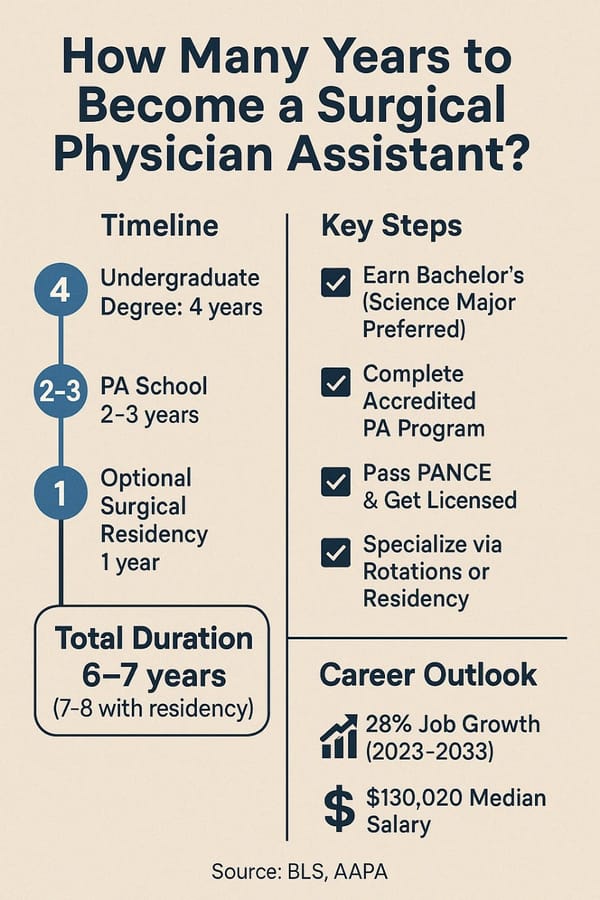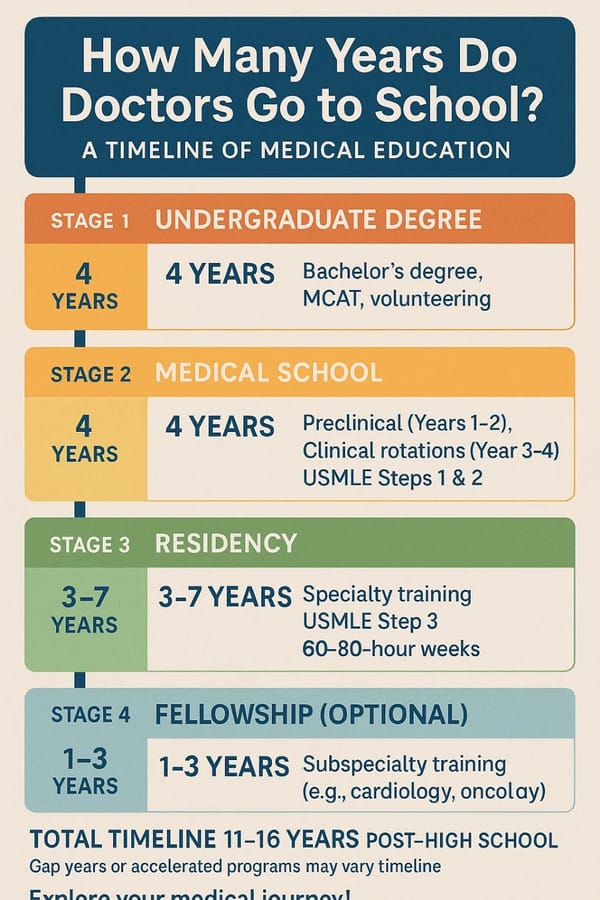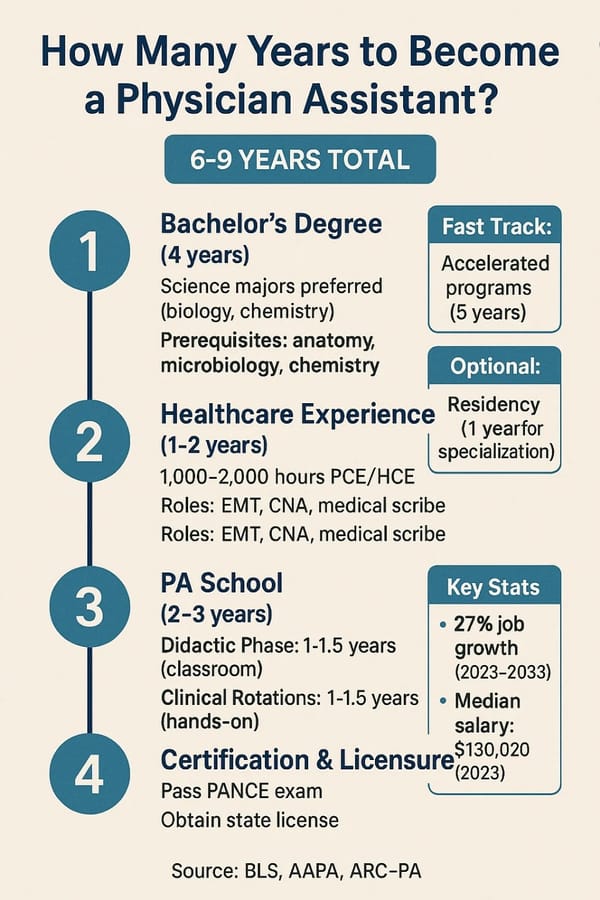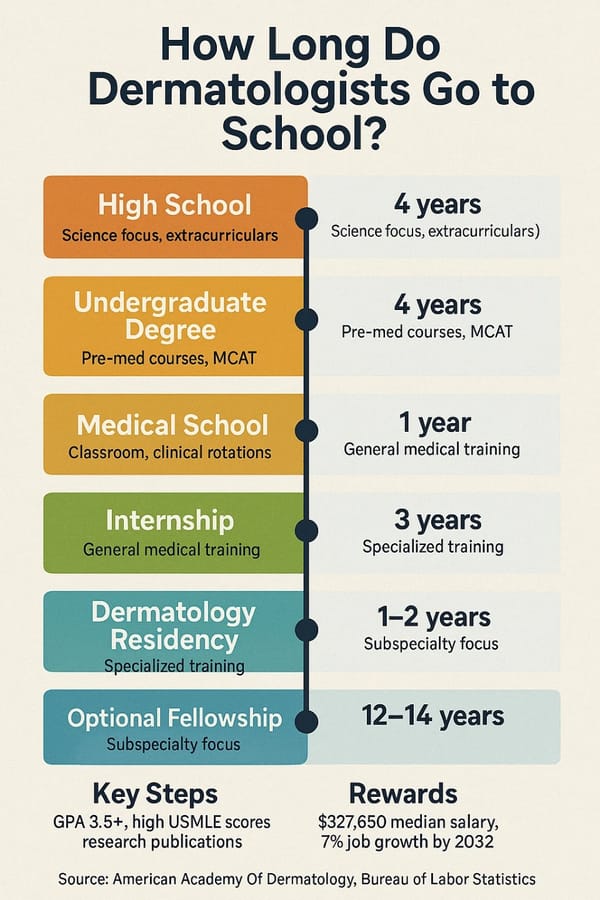Nurse Practitioner Career Path Calculator
How Long Does It Take to Become a Nurse Practitioner? A Comprehensive Guide
The journey to becoming a nurse practitioner blends hands-on clinical experience with rigorous educational requirements while providing rewarding outcomes. NPs function as advanced practice registered nurses who diagnose diseases prescribe medications and manage patient care while working with substantial independence. The U.S. healthcare system's growing need for primary care providers makes nurse practitioners' roles increasingly essential. According to the U.S. Bureau of Labor Statistics, NP employment is expected to increase by 40% from 2023 to 2033 which positions it among the fastest-growing professions[1]. What is the duration required to become a Nurse Practitioner? The duration to become an NP ranges between 6-8 years based on individual educational background and whether the chosen program is an MSN or DNP. The guide provides aspiring nurse practitioners with practical insights by detailing the educational timeline and key success factors.
Why Choose a Career as a Nurse Practitioner?
Individuals should explore a nurse practitioner career because it combines strong medical skills with the opportunity to form meaningful patient relationships while delivering quality care in shortage areas. Nurse Practitioners (NPs) combine clinical expertise with strong patient relationships to provide primary care services in communities with limited healthcare access. They earn competitive salaries—median annual pay was $126,260 in 2023, per the BLS—and mentions their ability to specialize in areas such as pediatrics, family practice, or psychiatric mental health. Many professionals including myself find it rewarding to make real-world impacts while progressing in our careers. Colleagues transitioning to NP positions find the change empowering yet recognize challenges when balancing work with their studies. Could this be the career shift you’re looking for?
The Educational Path: Step-by-Step Timeline
Becoming an NP requires multiple steps including completing a bachelor’s degree up to obtaining licensure. This section describes the typical educational path to becoming an NP along with different starting options.
Step 1: Complete your Bachelor of Science in Nursing (BSN) program
- Duration: ~4 years (full-time)
- Details: A Bachelor of Science in Nursing provides the essential education base for Nurse Practitioner programs through teaching nursing theory and clinical skills alongside patient care. It’s a prerequisite for most graduate programs. Registered nurses who hold an Associate Degree in Nursing (ADN) can complete RN-to-BSN programs within 1 to 2 years.
- Insight: Full-time BSN programs demand substantial commitment but accelerated courses exist for students who demonstrate high motivation. You can find accredited programs through the American Association of Nurse Practitioners website.
- Tip: Start researching schools early to find a program that fits your schedule and goals.
Step 2: Become a Licensed Registered Nurse (RN)
- Duration: A few months (for NCLEX-RN prep and testing)
- Details: To obtain RN licensure after completing your BSN you need to successfully complete the NCLEX-RN examination. This stage proceeds rapidly yet remains essential because licensure serves as a prerequisite to both practicing nursing and accumulating professional experience.
- Personal Note: Utilizing study materials from UWorld or Kaplan will facilitate efficient preparation. Using practice questions proved to be essential for developing my confidence before taking the exam.
- Source: The AANP confirms licensure as a key milestone.
Step 3: Gain Clinical Experience as an RN
- Duration: 1-2 years (recommended)
- Details: NP programs frequently demand RN experience because it develops clinical skills and allows students to identify their preferred specialties. Some programs, like those at Rockhurst University, students must complete a minimum of one year of experience to qualify for some program concentrations.
- Insight: Hospital RN practice allowed me to determine which NP specialty I wanted to pursue. These programs enable professional growth and validation of your career objectives.
- Tip: Use this period to network with NPs and learn about their roles.
Step 4: Complete a Graduate Nursing Program
Paths split here between the Master of Science in Nursing (MSN) option and the Doctor of Nursing Practice (DNP) route. Each has distinct timelines and goals.
Master of Science in Nursing (MSN)
- Duration: 2-3 years (full-time)
- Details: MSN programs prepare NPs through training in advanced clinical skills such as diagnostics and pharmacology and require completion of 500-600 clinical hours. Nurse.org reports that as of April 15, 2025 most nurse practitioners start their careers with an MSN degree.
- Pros: The MSN program is shorter than a DNP and more affordable while remaining widely recognized.
- Challenge: Students face challenges juggling both their clinical rotations and academic coursework. The NPs I knew supported their workload by participating in peer study groups.
- Source: Indeed.com notes MSN as the standard entry point.
Doctor of Nursing Practice (DNP)
- Duration: 3-4 years (full-time)
- Details: DNP programs build upon MSN education with additional leadership and health policy training and require more clinical hours which often exceed 1,000. Their design makes them well-suited for individuals who plan to pursue advanced nursing roles or academic careers.
- Source: According to Rockhurst University, DNP program duration ranges from 3 to 5 years based on your educational background.
- Trend: The healthcare industry debates whether DNP will become the standard credential by 2025 yet MSN qualifications continue to stand valid for present requirements.
Direct-Entry MSN (For Non-Nursing Degrees)
- Duration: 2.5-3 years
- Details: Direct-entry MSN programs train non-nursing bachelor's degree holders by merging basic nursing education with NP instruction. They’re intensive but efficient.
- Source: Rockhurst University describes these programs as an expedited path for individuals seeking to switch careers.
- Insight: A colleague with a biology degree used this path and was practicing in under 3 years.
Step 5: Obtain Certification and Licensure
- Duration: A few months
- Details: NPs complete their education by passing a national certification exam in their chosen specialty through organizations like ANCC or AANPCP. After national certification each state establishes its own specific licensure requirements.
- Source: The AANP states that certification is the last step before becoming a nurse practitioner.
- Tip: Prep early for the exam to streamline this phase.
Total Timeline: A Snapshot
This table offers typical timelines for full-time study programs.
| Path | Total Time | Breakdown |
|---|---|---|
| BSN to MSN | 6-7 years | 4 years for BSN education plus 1-2 years of RN experience followed by 2-3 years for MSN study |
| BSN to DNP | 7-8 years | completing a BSN degree in 4 years and RN experience of 1-2 years followed by obtaining a DNP in 3-4 years |
| ADN to BSN to MSN | 5-7 years | ADN (2 yrs) + BSN (1-2 yrs) + RN experience (1-2 yrs) + MSN (2-3 yrs) |
| Direct-Entry MSN | 2.5-3 years | Non-nursing bachelor’s degree holders can earn their MSN degree through a direct-entry program |
Note: Students who opt for part-time study or face clinical placement delays will see extended education timelines. Sources like Indeed.com alongside Davis & Elkins College agree that becoming a nurse practitioner usually takes between 6 to 8 years.
Factors That Affect the Timeline
Multiple factors have the potential to extend or shorten the duration of your educational path:
- Part-Time Study: Numerous programs such as those from Bradley University provide part-time study tracks which extend the duration by 1-3 years to accommodate working professionals.
- Clinical Hours: MSN programs mandate students to complete between 500 and 600 clinical hours while DNP programs demand more hours. Limited placement availability can delay completion.
- Specialty Choice: NP specialties such as neonatal or psychiatric care require additional coursework or clinical experience.
- Prior Education: Direct-entry programs recognize that ADN holders and career changers have distinct starting points.
The DNP Debate: What’s Happening in 2025?
The healthcare community actively discusses whether DNPs will become the standard entry degree for nurse practitioners. The American Association of Colleges of Nursing (AACN) has advocated for this educational shift to be completed by 2025 because they believe that the DNP degree better prepares NPs for modern healthcare environments. The transition to DNP as the entry-level degree for NPs remains unfinished as of April 15, 2025. Numerous states and employers continue to accept MSN-prepared NPs while MSN programs are still operational. NurseJournal.org indicates the transition to DNP programs may extend beyond the expected timeline and states students should check their specific state regulations[2].
Practical Tips for Aspiring NPs
- Research Programs Early: Evaluate accredited MSN and DNP programs based on their tuition fees, educational delivery methods, and available nurse practitioner specializations. Start with resources like the AANP.
- Leverage RN Experience: Apply your RN experience to explore various specialties and establish connections with NPs.
- Plan Financially: Graduate programs are costly. Look into scholarships or employer tuition support.
- Stay Informed: To keep updated on DNP requirements check Franklin University or consult state boards.
Conclusion: Your Path to Becoming an NP
Most people need between six to eight years to become nurse practitioners by completing a BSN program (4 years), RN experience (1-2 years), and graduate studies (2-4 years for MSN or DNP). Direct-entry MSN programs offer a faster route, taking 2.5-3 years for those with non-nursing bachelor’s degrees, while ADN-to-MSN paths may span 5-7 years. Factors like part-time study, clinical hour availability, or specialty choices can adjust this timeline. With NPs in high demand and the DNP debate ongoing, now’s an ideal time to pursue this career. Explore accredited programs at schools like Rockhurst University to start your journey. Ready to make a difference in healthcare? Share your plans or questions below!
